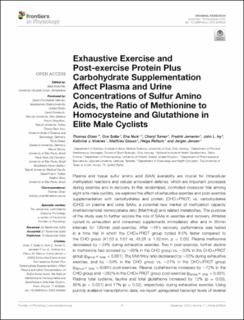| dc.contributor.author | Olsen, Thomas | |
| dc.contributor.author | Sollie, Ove | |
| dc.contributor.author | Nurk, Eha | |
| dc.contributor.author | Turner, Cheryl | |
| dc.contributor.author | Jernerén, Fredrik | |
| dc.contributor.author | Ivy, John L. | |
| dc.contributor.author | Vinknes, Kathrine | |
| dc.contributor.author | Clauss, Matthieu | |
| dc.contributor.author | Refsum, Helga Margaretha | |
| dc.contributor.author | Jensen, Jørgen | |
| dc.date.accessioned | 2021-03-04T14:42:57Z | |
| dc.date.available | 2021-03-04T14:42:57Z | |
| dc.date.created | 2020-12-15T07:47:00Z | |
| dc.date.issued | 2020 | |
| dc.identifier.citation | Frontiers in Physiology. 2020, 11(2020), Artikkel 609335. | en_US |
| dc.identifier.issn | 1664-042X | |
| dc.identifier.uri | https://hdl.handle.net/11250/2731718 | |
| dc.description | This is an open-access article distributed under the terms of the Creative Commons Attribution License (CC BY). The use, distribution or reproduction in other forums is permitted, provided the original author(s) and the copyright owner(s) are credited and that the original publication in this journal is cited, in accordance with accepted academic practice. No use, distribution or reproduction is permitted which does not comply with these terms. | en_US |
| dc.description.abstract | Plasma and tissue sulfur amino acid (SAA) availability are crucial for intracellular methylation reactions and cellular antioxidant defense, which are important processes during exercise and in recovery. In this randomized, controlled crossover trial among eight elite male cyclists, we explored the effect of exhaustive exercise and post-exercise supplementation with carbohydrates and protein (CHO+PROT) vs. carbohydrates (CHO) on plasma and urine SAAs, a potential new marker of methylation capacity (methionine/total homocysteine ratio [Met/tHcy]) and related metabolites. The purpose of the study was to further explore the role of SAAs in exercise and recovery. Athletes cycled to exhaustion and consumed supplements immediately after and in 30 min intervals for 120 min post-exercise. After ~18 h recovery, performance was tested in a time trial in which the CHO+PROT group cycled 8.5% faster compared to the CHO group (41:53 ± 1:51 vs. 45:26 ± 1:32 min, p < 0.05). Plasma methionine decreased by ~23% during exhaustive exercise. Two h post-exercise, further decline in methionine had occured by ~55% in the CHO group vs. ~33% in the CHO+PROT group (pgroup × time < 0.001). The Met/tHcy ratio decreased by ~33% during exhaustive exercise, and by ~54% in the CHO group vs. ~27% in the CHO+PROT group (pgroup × time < 0.001) post-exercise. Plasma cystathionine increased by ~72% in the CHO group and ~282% in the CHO+PROT group post-exercise (pgroup × time < 0.001). Plasma total cysteine, taurine and total glutathione increased by 12% (p = 0.03), 85% (p < 0.001) and 17% (p = 0.02), respectively during exhaustive exercise. Using publicly available transcriptomic data, we report upregulated transcript levels of skeletal muscle SLC7A5 (log2 fold-change: 0.45, FDR:1.8e−07) and MAT2A (log2 fold-change: 0.38, FDR: 3.4e−0.7) after acute exercise. Our results show that exercise acutely lowers plasma methionine and the Met/tHcy ratio. This response was attenuated in the CHO+PROT compared to the CHO group in the early recovery phase potentially affecting methylation capacity and contributing to improved recovery. | en_US |
| dc.language.iso | eng | en_US |
| dc.subject | protein supplementation | en_US |
| dc.subject | carbohydrate supplementation | en_US |
| dc.subject | exercise | en_US |
| dc.subject | performance | en_US |
| dc.subject | methylation | en_US |
| dc.subject | oxidative stress | en_US |
| dc.title | Exhaustive exercise and post-exercise protein plus carbohydrate supplementation affect plasma and urine concentrations of sulfur amino acids, the ratio of methionine to homocysteine and glutathione in elite male cyclists | en_US |
| dc.type | Peer reviewed | en_US |
| dc.type | Journal article | en_US |
| dc.description.version | publishedVersion | en_US |
| dc.rights.holder | © 2020 Olsen, Sollie, Nurk, Turner, Jernerén, Ivy, Vinknes, Clauss, Refsum and Jensen | en_US |
| dc.source.pagenumber | 13 | en_US |
| dc.source.volume | 11 | en_US |
| dc.source.journal | Frontiers in Physiology | en_US |
| dc.source.issue | 2020 | en_US |
| dc.identifier.doi | 10.3389/fphys.2020.609335 | |
| dc.identifier.cristin | 1859796 | |
| dc.description.localcode | Institutt for fysisk prestasjonsevne / Department of Physical Performance | en_US |
| dc.source.articlenumber | 609335 | en_US |
| cristin.ispublished | true | |
| cristin.fulltext | original | |
| cristin.qualitycode | 1 | |
